The Giant Behemoth (1959)
Directed by: Douglas Hickox, Eugène Lourié
Written by: Allen Adler, Daniel James, Eugène Lourié, Robert Abel
Starring: André Morell, Gene Evans, John Turner, Leigh Madison
AKA BEHEMOTH, THE SEA MONSTER
UK/USA
AVAILABLE ON BLU-RAY [REGION ‘A’ ONLY], DVD and DIGITAL
RUNNING TIME: 80 mins, 78 mins [UK cinema release]
REVIEWED BY: Dr Lenera
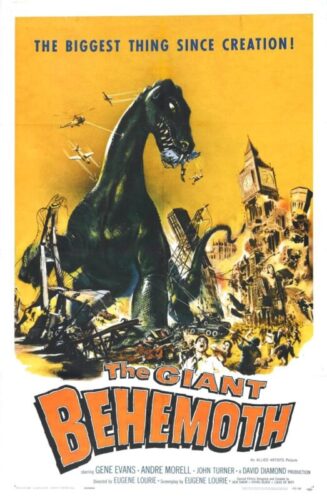
Scientist Steve Karnes is very concerned about the dangers to marine life posed by nuclear testing. A real-life example of his concern materialises when a fisherman in Looe, Cornwall, is killed on the beach, and his dying word is “Behemoth”. Then thousands of dead fish are washed ashore and a passenger ship found wrecked. Karnes and colleague Professor James Bickford investigate. The fisherman’s injuries seem to include radiation burns, and in London, they discover that samples of the dead fish contain large amounts of radioactive contamination. Karnes begins to suspect that the “behemoth” that the fisherman mentioned is some kind of large marine animal that has mutated as a result of being contaminated by nuclear testing. Palaeontologist Dr. Sampson identifies as a Paleosaurus, an aquatic dinosaur that emits a pulse like that of an electric eel….

Ray Harryhausen often said that that the 1933 King Kong was what inspired his career and was also his favourite movie. He eventually worked with that film’s special effects creator Willis O’ Brien, the father of stop motion who introduced the form in the silent days, in 1949 on Mighty Joe Young, which also featured an oversized ape, though not nearly as large. The Beast From 20 000 Fathoms saw Harryhausen strike out on his own, and O’ Brien must have been proud, but he himself had trouble getting projects off the ground, and it must have been both strange and sad for him to work on The Giant Behemoth, which is basically a remake of The Beast From 20 000 Fathoms, but with a much lower budget. On it, O’ Brien had to do stuff which was often imitating the work of his former protege, but could rarely match it because of having less money and resources at his disposal. This must have frustrated him deeply, and anyone watching The Giant Behemoth who hasn’t seen any other O’ Brien material may well wonder if O’ Brien’s reputation is unfounded, because what we mostly see is several significant steps back from Harryhausen’s work, often looking quite primitive, and sometimes having to resort to repetition of shots to male the special effects sequences longer in a production where money was clearly running out. The final third shows a lot of evidence of cut corners, from crowd scenes where we don’t hear the people talking, to extras seen waiting for action in dissolves, to loads of stock footage of being used to complete scenes, the latter being painfully obvious in High Definition. Still, the rehash still can’t help but excite in places due to its basic plot, and the addition of the electrocution pulse is a nice and rather frightening touch. The pacing is really tight, though the human side of things is pretty dull this around.
So The Beast From 20 000 Fathoms was a big hit, and started a craze of similar films. Lourie’s next job was Paramount’s The Colossus Of New York, about a scientist who, on the day he’s awarded the Nobel Prize, is killed in a traffic accident. His father and brother place his brain in a large robot. It’s surprisingly thought-provoking, and with a very memorable laboratory sequence, if low on thrills. Next up was an unnamed project, initiated by producer Ted Lloyd, about a deadly, invisible alien, but the backers rejected it at the last minute, so Robert Abel and Allen Adler were asked to quickly think of another giant monster tale which Lourie turned into a screenplay with Daniel James. With far less information easily available about this film, I don’t know if Lourie was asked to heavily lean on The Beast From 20 000 Fathoms, or whether he was just so rushed he had to re-use a lot of previously used plot elements and scenes. Money was so tight that O’ Brien and Pete Peterson completed most of the stop motion on a table in Peterson’s garage. I also couldn’t find out which scenes were directed by Lourie and which ones by credited co-director Douglas Hickox. For all its roughness, the film does seem like the work of one person. Allied Artists distributed it in the US to reasonable success; Eros Films released it in the UK, where the BBFC gave it an ‘X’ certificate. A version with exactly two minutes removed and retitled Behemoth, the Sea Monster, was given an ‘A’ certificate four days later. Some fans of these kinds of movies weren’t happy when, in 2007, two special effects artists of more recent years, Phil Tippett and Dennis Muren, spent most of a DVD audio commentary being condescending, and mocking not just the film but also O’ Brien’s work; maybe more annoying to me is that they didn’t seem to have done any research, sometimes simply saying “I don’t know”.
A voice says “And the lord said, behold now the behemoth”, a quote from the Bible, as we seem to adopt the point of view of somebody on a boat bobbing up and down on the ocean. Stock shots of atomic explosions follow, plus one which looks like it was staged for the film as it lacks grain; it’s pretty impressive, us looking down on an explosion on the sea engulfing ships. The narrator is revealed to be Karnes, his worry about what these tests well explained as he describes how not just a whopping 142 nuclear explosion may have been dangerous but the dumping of nuclear waste, the latter maybe causing a chain in the wildlife as the radio activity gets much higher as it’s passed on. “For all we know, what we have started may already have materialised, might rise to the surface and strike back at us”. Well there’s foreshadowing for you, but actually this part of the story, at least in terms of how its presented, convinces more than that Rhedosaurus being awakened and released by that single nuclear blast. Meanwhile in Cornwall a fisherman and his daughter are returning to land with a good catch and the fisherman goes off to the pub to boast, but never gets there, hearing a bleeping noise on the beach before seeing some odd white formation on the sand. Touching it causes him to clutch his face in agony as white wisps fill the scream. It’s the first of several similar moments which take this one slightly closer to the horror movie than its predecessor. The daughter looks for him and gets a man from the pub to help her. He’s found with burns on his face. “What was it”? ” Behemoth” is the reply. It’s a rather strange reply really, being put in just so the film’s title is referred to, just like during the pretty odd speech given at his funeral.
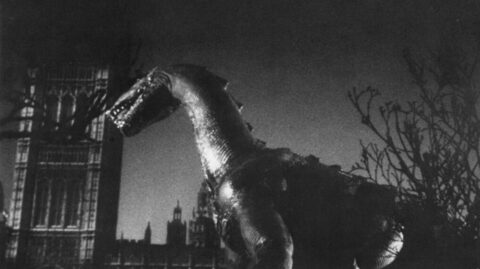
Nonetheless the build-up here is certainly quite ominous, the sight of thousand of dead fish on the beach startles, then Karnes sees a TV report about the sighting of a “sea monster” despite the newsreader taking the micky. He talks to Bickford and learns that the media reports about the killing on the beach omitted the burn element. At the habour in Looe, a man says that he saw a pair of lights under the water. Karnes and Bickford take loads of the fish to a laboratory where they are cut open to see if they contain radioactive particles – the sight of one slicing no doubt being something that was removed from the Behemoth, The Sea Monster version in addition to the shots of burnings and burn victims. The Beast From 20 000 Fathoms had that overlong but suspenseful scene where loads of pictures of dinosaurs are looked at before the Rhedosaurus is recognised; here we get just two slides of fish come up before one that shows radioactivity comes up. It’s just after here that the Behemoth is finally seen, though only a shot of its back. Tests reveal that the gloopy white stuff has probably come from the stomach of some huge creature, then a boy on a farm is killed and gigantic foot prints left. Like when in The Beast From 20 000 Fathoms Tom Nesbitt visits Thurgood Elson, Karnes and Bickford go see a palaeotologist, Dr. Sampson, the curator of the Natural History Museum. He identifies the creature as a Paleosaurus [which is also ficticious], and says that it’s heading for “The freshwater rivers to die” just like its dead relatives. The Police Chief strangely won’t evacuate the area around the Thames, deciding just to employ radar, meaning that when the Behemoth rises out of the river to destroy a ferry, people just aren’t ready. After this, it’s not particularly thrilling storytelling to tell us how the Behemoth will be destroyed before its big rampage [at least the previous film only suggested], and the underwater climax lacks both atmosphere and tension, though the Behemoth dies in a pretty impressive explosion.
There just wasn’t enough money to show the Behemoth in full several times early on like the far luckier Beast, so, with only the last twenty minutes showing the Behemoth in full, a lot hinges on these scenes, but they tend to disappoint. The ferry destruction employs a stiff puppet and the London rampage that follows soon after has too many repeated close-ups of the Behemoth’s face as he chases crowds, the face being rather unexpressive while the Beast’s seemed to evoke some emotion, a creature lost and confused. The same car is also stomped several times. Design-wise the Behemoth looks fine, but for heaven’s sake we can see the model tearing in one low angle shot, though at least that explains why there aren’t many other similar shots, sequences often looking like shots are missing. O’ Brien only occasionally does what Harryhausen liked to do, splitting a live-action plate for a more photo-real effect; he usually prefers to build elaborate models. These do look good, and the matching of perspective is great, but sometimes photograph blowups are also used for the Behemoth to walk in front of, and these are variable in quality; along with some probably cardboard silhouettes they really show how laughably tiny the budget was, but they’re certainly interesting to look at, especially the Behemoth coming out between the towers of Westminster Abbey. Then there’s the drawings which represent burnt bodies, the frequent stock footage of helicopters, wrecked ships etc. to complete scenes, two mostly silent scenes, and even the use of sound effects from King Kong, even Fay Wray’s very recognisable scream. At the end of the day the filmmakers did what they could with what they had, so one perhaps shouldn’t be too churlish, but then this is also a film where a reporter is shown in close up but his mouth movements and dialogue don’t match.
It’s perhaps refreshing not to have some romance, but, what with none of the occasionally interesting dimensions that could be found in The Beast From 20 000 Fathoms, there’s little human stuff of interest except for slight differences of opinion between Karnes and Bickford. The role of Karnes, made American so the film could have an American “star” like quite a few British genre films of the time [presumably in an attempt to appeal more to the US market seeing as I can’t see how someone like Gene Evans would have made much difference to UK box office takings] is largely to make predictions before they can be proved but which turn out to be accurate anyway. The presence of Andre Morell is always welcome but, as the very polite Bickford, he’s clearly going through the motions here. Edwin Astley’s musical score is a bit busier than Buttolph’s, though obviously uses a smaller orchestra too which sometimes seems to struggle to make the impact it should. Some of his early music is extremely ominous, and then there’s that electronic sound when the Behemoth often appears, but, despite his main monster music sometimes incoporating the same two-note motif as the Jaws theme, there’s nothing in the score that’s really memorable. Overall The Giant Behemoth can’t help but be enjoyable for dinosaur and giant monster movie lovers, but it should have been much better and doesn’t hold a candle to The Beast From 20 000 Fathoms.
Rating: 











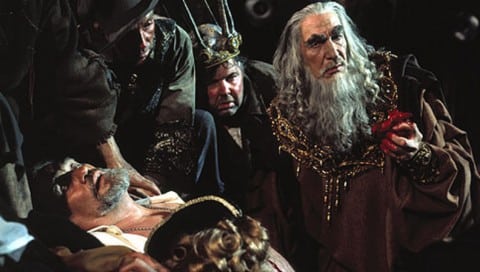
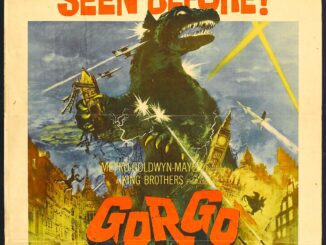
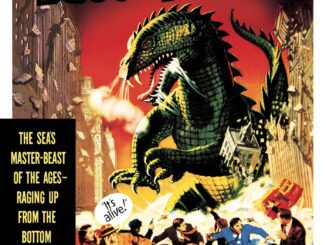
Be the first to comment